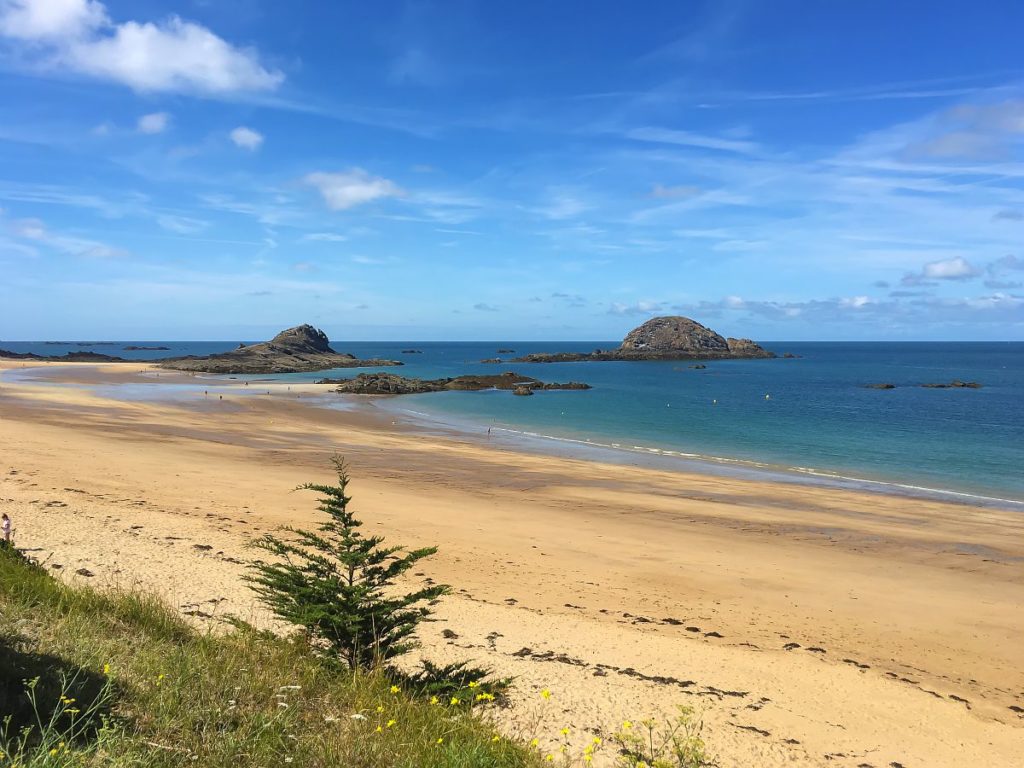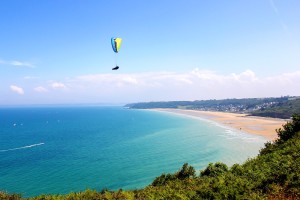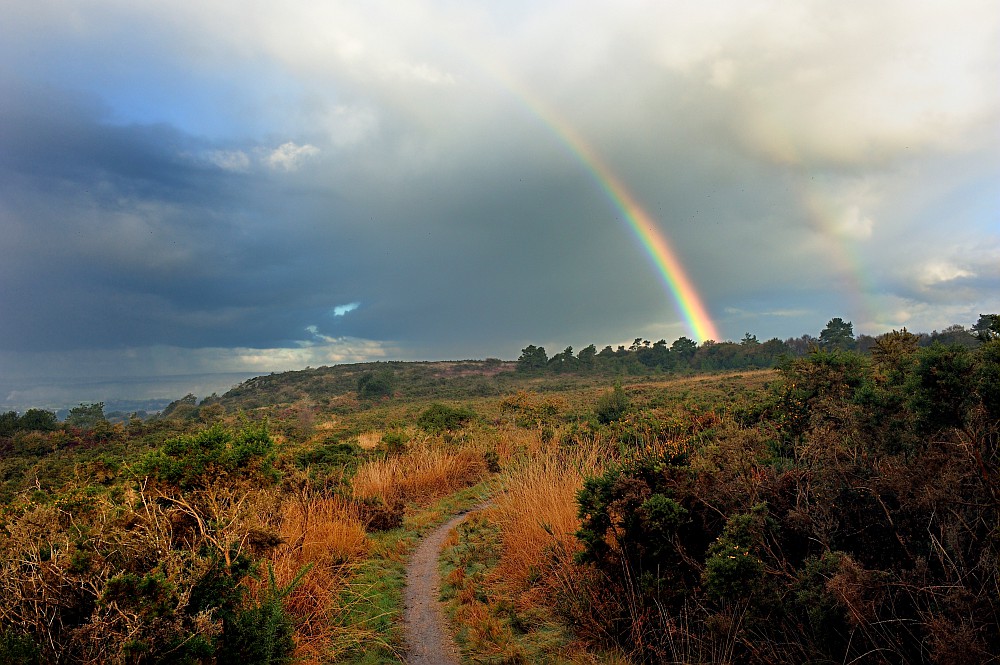
Compared to other regions in France, the weather in Brittany is quite unpredictable. Thick autumn fog on the Côte de Granit Rose, fierce winter storms on an island off the coast of Brittany or continuous summer rain in the Argoat, the forest country in the heart of Brittany, demand a lot from even the most weatherproof holidaymaker. On the other hand, the climate also has real surprises in store.
For example, in the North Finistère, which is rainy even by Breton standards, there are unexpected periods of good weather in summer, when the beaches are inviting for a swim. In the almost subtropical climate of the Gulf of Morbihan, exotic plants thrive against the backdrop of a turquoise sea. And a spectacle in any weather are Brittany’s light and cloud formations, phenomena that have captivated many artists.
Discover now:
Best Holiday Weather
So what is the best weather for travelling? When planning a holiday, this question is one of the most important. Regardless of some weather-related imponderables, some general statements can be made. In late autumn, winter and at the beginning of spring, there is little activity in the northwest of France due to the uncomfortable weather. After Easter, the weather calms down and the holiday homes slowly start to fill up. For many, the best time to travel to Brittany is May and June, when it is already warm but the popular destinations are still comparatively lonely. July and August is the peak holiday season across France.
The holidaying French are joined by Brittany tourists from the Benelux, the British Isles and Germany. This is the time when you are most likely to catch a few days of bathing weather. In September, when temperatures slowly drop degree by degree and rainfall rises just as slowly, the low season becomes the high season for holidaymakers who don’t have to stick to the general school holidays. Late summer and early autumn then entice visitors not only with secluded beaches, but also the forests of Brittany with bright colours.
Weather In Selected Places
The weather in Brittany is determined by the sea. Mild temperatures therefore prevail throughout the year. Summers are not too hot on average, and sub-zero temperatures are the absolute exception in the winters. Frost and snow only occur once a year.
Brest
The weather in Brest, the city in the far north-west of France, is more dependent on the sea than almost any other place in Brittany. Brest has the most rainy days of the cities compared here, with 151, and meteorologists record a rainfall of 1,085 mm per year.
Average temperature Brest:
- Average July: 12.4 – 20.1°C
- Average January: 3.9 – 8.7°C
Quimper
The weather in Quimper is representative of the weather in much of southern Brest. Quimper is 15 kilometres from the sea and is not a coastal town. Nevertheless, the weather is strongly maritime. Temperatures are mild, summers are slightly warmer in Quimper than in northern Brittany, and the number of rainy days is lower than in Brest.
Average temperature Quimper:
- Average July: 13.3 – 21.7°
- Average January: 3.9 – 9.1°C
Rennes
Rennes, the capital of Brittany, is blessed with better weather on average than many places on the coast. The sun shines more often, the weather in Rennes is not subject to such strong fluctuations as, for example, the weather in Brest. Basically, conditions are stable.
Average temperature Rennes:
- Average July: 12.7 – 23.4°C
- Average January: 1.8 – 7.8°C
Saint-Malo
As the city is located on the coast of the English Channel, the Gulf Stream determines the weather in Saint-Malo. Like everywhere else in Brittany, the weather is mild with moderate temperatures and maritime rainfall.
Average temperature Saint-Malo:
- Average July: 13.5 – 21.9°C
- Average January: 3.4 – 8.8°C
Water Temperature Brittany

According to a Breton joke, the water temperature in Brittany is a constant 28°C: 14°C in the morning and 14°C in the evening.
But how warm is the sea really? And which sections are the best beaches for swimming in Brittany? The underlying question of the most pleasant water temperature is one that moves holidaymakers in the north-west of France as much as it does the Bretons every summer.
The temperature of the water depends on several factors. The weather has the greatest influence: if high pressure determines the weather conditions, such as in the hot months of June, July and August 2019 throughout Europe, the water near the beach also warms up more than average under the sun’s rays. However, the sea in Brittany will never be as warm as the Baltic Sea that summer.
In the Atlantic, the waters are deeper and take longer to heat up. On the other hand, the cooling influence of ocean currents from the open ocean is also noticeable in the regions near the coast.
Regardless of the location of the beaches, the tides also play their part in the water temperature. The high tide always brings cool water, while the water receding at low tide is always somewhat warmer.
The cooling effects are countered by a warming one. Where rivers flow into the ocean, water temperatures are higher on average than far away from estuaries.
This gives a clear determination of where bathing is freshest in Brittany. The “Fromveur” ocean current between the island of Ouessant and the mainland gives the whole of northern Finistère cool water temperatures. The influence of the powerful current can be measured as far as the eastern border of the Trégor region; the thermometer only shows higher temperatures from the bay of Saint-Brieuc. In summer, you can look forward to average temperatures of between 16°C and 18°C when swimming.
Beaches along the English Channel benefit the most, with Cancale being particularly noteworthy. If you follow the coast of Ille-et-Vilaine and Côtes-d’Armor in a counter-clockwise direction, the beaches with the freshest water temperatures are in Finistère. The water temperature only rises above 16°C in exceptional cases, especially in northern Finistère and on the west coast; 14°C is more the norm.
In southern Finistère and Morbihan it is more pleasant. The values here are similar to those on the north-east coast of Brittany. In summer, water sports enthusiasts and bathers can expect water temperatures of around 18°C upwards between Clohars-Carnoët and La Baule.
Precise forecasts and status reports are provided by the “Météo plage”. The beach weather report is part of the evening news broadcasts on TV and can be called up for Brittany at any time here: http://www.meteocity.com/plage/bretagne
Rain In Brittany

“Breton Rain” is not a new book by Jean-Luc Bannalec, in which Inspector Dupin solves another tangled case. Rain is nothing unusual in Brittany; Bretons and experienced Brittany travellers are not blindsided by a shower. Drizzle, blustery showers, steady rain – Brittany, part of the humid Atlantic front from Portugal to Scotland, has all sorts of rain. The good news: just as quickly as the rain comes, it can also move on again.
Brittany owes its changeable weather to the strong influence of the tides and the wind and water currents of the Atlantic. These two phenomena are also responsible for the many microclimatic zones in which very specific weather patterns can develop. Places only a few kilometres apart sometimes have completely different conditions on the same day. For example, it can rain continuously in Morlaix, while there is no sign of it in Carantec, 15 kilometres away. The example of these two places also shows a phenomenon that applies to the entire region: on average, it rains less on the coast than in the interior of the country.
For a holiday region, such weather could actually be anti-advertising. But enthusiasts appreciate the advantages that the climatic conditions bring. Mass tourism with accompanying symptoms such as overcrowded beaches and bed castles that disfigure the landscape will not be found in Brittany. The chance of sunburn, dehydration or heat stroke marring your stay is rare. The landscape is constantly lush green, and palms and other plants with high water consumption thrive in Brittany’s humid weather.
Brittany can give even less of a fair-weather guarantee than other holiday regions. Optimists see this circumstance as the pinch of adventure that a holiday in Brittany brings. The weather makes it necessary to make certain preparations for a holiday in Brittany. Without rainproof clothing, Brittany holidaymakers are considerably restricted in their freedom of movement. A rain jacket, umbrella and water-repellent footwear are a must to avoid being stuck in the holiday home on bad days. Good books help to bridge the rainy days. If you like cooking, you can plan plenty of time for it.
Perhaps the most important thing is the inner attitude. If you are surprised by the rain, there is no point in being in a bad mood. The forces of nature won’t care and you’ll spoil your holiday. For a relaxed holiday, it’s best to make peace with the weather in Brittany. Take the weather as it comes. That way, you’ll avoid a low mood and enjoy the beautiful weather in Brittany all the more!
Comité Régional du Tourisme de Bretagne | Donatienne Guillaudeau, © Yanick Le Gal (Saint-Malo), © Yvon BOËLLE
